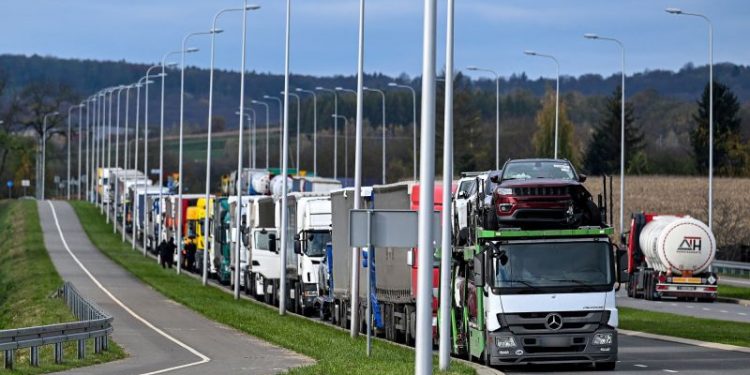The Ukraine-Poland border is currently witnessing a unique and challenging situation, as approximately 20,000 trucks find themselves stranded due to a dispute over access to the European Union (EU). This unexpected conflict has created significant disruptions in trade and transportation, affecting both countries involved and highlighting the complexities of cross-border relations.
The root cause of this border standoff can be traced back to Ukraine’s efforts to join the EU and gain access to its single market, which promises economic growth and prosperity. In recent years, Ukraine has been diligently working towards fulfilling the necessary requirements and implementing reforms to meet EU standards. However, despite these efforts, Poland has raised concerns regarding the compliance of Ukrainian trucks with EU regulations, particularly safety standards and technical specifications.
Poland, being an EU member, holds the responsibility of ensuring the safe passage of goods and maintaining the integrity of its single market. Consequently, it has imposed strict controls on trucks entering its territory, exacerbating the already complex situation at the border. These measures have created lengthy queues, resulting in heavy congestion and leaving thousands of trucks stranded.
The consequences of this border dispute are reverberating beyond the immediate parties involved. The truck drivers, who are facing grueling conditions in their vehicles while waiting for a resolution, are enduring physical and mental strains. Moreover, the disruption in trade has led to severe economic losses for both Ukraine and Poland, as well as for European businesses that rely on cross-border transportation.
Finding a resolution to this issue is crucial for the smooth functioning of trade and for maintaining the bilateral relations between Ukraine and Poland. It requires a delicate balance between ensuring adherence to EU regulations and addressing the concerns raised by Ukraine. The EU, as a mediator, should play an active role in bringing the two countries to the negotiating table and facilitating a mutually beneficial solution.
Ukraine, on its part, must expedite its efforts to meet the required EU standards. This includes enhancing safety measures and technical specifications for its trucks to gain the trust and confidence of Poland and other EU member states. Simultaneously, Poland should consider temporary measures to ease the congestion at the border, such as increasing staff and facilities to expedite the inspection process.
It is worth noting that this border dispute is a symptom of a larger issue: Ukraine’s journey towards EU integration. As Ukraine strives to align itself with EU standards, the challenges encountered along the way highlight the need for continuous support and collaboration. The EU must recognize the progress made by Ukraine and provide guidance and assistance to overcome obstacles that arise during this transformational process.
In conclusion, the current crisis at the Ukraine-Poland border, with 20,000 trucks stuck amidst a spat over access to the EU, underscores the complexities of cross-border relations and the challenges associated with EU integration. Resolving this issue requires a concerted effort from all parties involved, emphasizing the importance of adherence to EU regulations while finding pragmatic solutions. The situation serves as a reminder of the need for consistent support and collaboration between Ukraine, Poland, and the EU as Ukraine continues on its path towards EU membership.

















